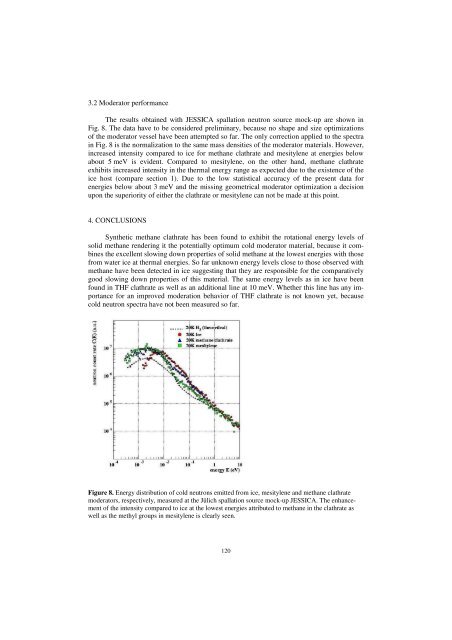Druck-Materie 20b.qxd - JUWEL - Forschungszentrum Jülich
Druck-Materie 20b.qxd - JUWEL - Forschungszentrum Jülich
Druck-Materie 20b.qxd - JUWEL - Forschungszentrum Jülich
You also want an ePaper? Increase the reach of your titles
YUMPU automatically turns print PDFs into web optimized ePapers that Google loves.
3.2 Moderator performance<br />
The results obtained with JESSICA spallation neutron source mock-up are shown in<br />
Fig. 8. The data have to be considered preliminary, because no shape and size optimizations<br />
of the moderator vessel have been attempted so far. The only correction applied to the spectra<br />
in Fig. 8 is the normalization to the same mass densities of the moderator materials. However,<br />
increased intensity compared to ice for methane clathrate and mesitylene at energies below<br />
about 5 meV is evident. Compared to mesitylene, on the other hand, methane clathrate<br />
exhibits increased intensity in the thermal energy range as expected due to the existence of the<br />
ice host (compare section 1). Due to the low statistical accuracy of the present data for<br />
energies below about 3 meV and the missing geometrical moderator optimization a decision<br />
upon the superiority of either the clathrate or mesitylene can not be made at this point.<br />
4. CONCLUSIONS<br />
Synthetic methane clathrate has been found to exhibit the rotational energy levels of<br />
solid methane rendering it the potentially optimum cold moderator material, because it combines<br />
the excellent slowing down properties of solid methane at the lowest energies with those<br />
from water ice at thermal energies. So far unknown energy levels close to those observed with<br />
methane have been detected in ice suggesting that they are responsible for the comparatively<br />
good slowing down properties of this material. The same energy levels as in ice have been<br />
found in THF clathrate as well as an additional line at 10 meV. Whether this line has any importance<br />
for an improved moderation behavior of THF clathrate is not known yet, because<br />
cold neutron spectra have not been measured so far.<br />
Figure 8. Energy distribution of cold neutrons emitted from ice, mesitylene and methane clathrate<br />
moderators, respectively, measured at the <strong>Jülich</strong> spallation source mock-up JESSICA. The enhancement<br />
of the intensity compared to ice at the lowest energies attributed to methane in the clathrate as<br />
well as the methyl groups in mesitylene is clearly seen.<br />
120

















